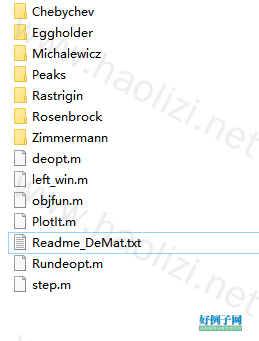实例介绍
【实例简介】
【实例截图】

【核心代码】
function [FVr_bestmem,S_bestval,I_nfeval] = deopt(fname,S_struct)
%-----This is just for notational convenience and to keep the code uncluttered.--------
I_NP = S_struct.I_NP;
F_weight = S_struct.F_weight;
F_CR = S_struct.F_CR;
I_D = S_struct.I_D;
FVr_minbound = S_struct.FVr_minbound;
FVr_maxbound = S_struct.FVr_maxbound;
I_bnd_constr = S_struct.I_bnd_constr;
I_itermax = S_struct.I_itermax;
F_VTR = S_struct.F_VTR;
I_strategy = S_struct.I_strategy;
I_refresh = S_struct.I_refresh;
I_plotting = S_struct.I_plotting;
%-----Check input variables---------------------------------------------
if (I_NP < 5)
I_NP=5;
fprintf(1,' I_NP increased to minimal value 5\n');
end
if ((F_CR < 0) | (F_CR > 1))
F_CR=0.5;
fprintf(1,'F_CR should be from interval [0,1]; set to default value 0.5\n');
end
if (I_itermax <= 0)
I_itermax = 200;
fprintf(1,'I_itermax should be > 0; set to default value 200\n');
end
I_refresh = floor(I_refresh);
%-----Initialize population and some arrays-------------------------------
FM_pop = zeros(I_NP,I_D); %initialize FM_pop to gain speed
%----FM_pop is a matrix of size I_NPx(I_D 1). It will be initialized------
%----with random values between the min and max values of the-------------
%----parameters-----------------------------------------------------------
for k=1:I_NP
FM_pop(k,:) = FVr_minbound rand(1,I_D).*(FVr_maxbound - FVr_minbound);
end
FM_popold = zeros(size(FM_pop)); % toggle population
FVr_bestmem = zeros(1,I_D);% best population member ever
FVr_bestmemit = zeros(1,I_D);% best population member in iteration
I_nfeval = 0; % number of function evaluations
%------Evaluate the best member after initialization----------------------
I_best_index = 1; % start with first population member
S_val(1) = feval(fname,FM_pop(I_best_index,:),S_struct);
S_bestval = S_val(1); % best objective function value so far
I_nfeval = I_nfeval 1;
for k=2:I_NP % check the remaining members
S_val(k) = feval(fname,FM_pop(k,:),S_struct);
I_nfeval = I_nfeval 1;
if (left_win(S_val(k),S_bestval) == 1)
I_best_index = k; % save its location
S_bestval = S_val(k);
end
end
FVr_bestmemit = FM_pop(I_best_index,:); % best member of current iteration
S_bestvalit = S_bestval; % best value of current iteration
FVr_bestmem = FVr_bestmemit; % best member ever
%------DE-Minimization---------------------------------------------
%------FM_popold is the population which has to compete. It is--------
%------static through one iteration. FM_pop is the newly--------------
%------emerging population.----------------------------------------
FM_pm1 = zeros(I_NP,I_D); % initialize population matrix 1
FM_pm2 = zeros(I_NP,I_D); % initialize population matrix 2
FM_pm3 = zeros(I_NP,I_D); % initialize population matrix 3
FM_pm4 = zeros(I_NP,I_D); % initialize population matrix 4
FM_pm5 = zeros(I_NP,I_D); % initialize population matrix 5
FM_bm = zeros(I_NP,I_D); % initialize FVr_bestmember matrix
FM_ui = zeros(I_NP,I_D); % intermediate population of perturbed vectors
FM_mui = zeros(I_NP,I_D); % mask for intermediate population
FM_mpo = zeros(I_NP,I_D); % mask for old population
FVr_rot = (0:1:I_NP-1); % rotating index array (size I_NP)
FVr_rotd = (0:1:I_D-1); % rotating index array (size I_D)
FVr_rt = zeros(I_NP); % another rotating index array
FVr_rtd = zeros(I_D); % rotating index array for exponential crossover
FVr_a1 = zeros(I_NP); % index array
FVr_a2 = zeros(I_NP); % index array
FVr_a3 = zeros(I_NP); % index array
FVr_a4 = zeros(I_NP); % index array
FVr_a5 = zeros(I_NP); % index array
FVr_ind = zeros(4);
FM_meanv = ones(I_NP,I_D);
I_iter = 1;
while ((I_iter < I_itermax) & (S_bestval.FVr_oa(1) > F_VTR))
FM_popold = FM_pop; % save the old population
S_struct.FM_pop = FM_pop;
S_struct.FVr_bestmem = FVr_bestmem;
FVr_ind = randperm(4); % index pointer array
FVr_a1 = randperm(I_NP); % shuffle locations of vectors
FVr_rt = rem(FVr_rot FVr_ind(1),I_NP); % rotate indices by ind(1) positions
FVr_a2 = FVr_a1(FVr_rt 1); % rotate vector locations
FVr_rt = rem(FVr_rot FVr_ind(2),I_NP);
FVr_a3 = FVr_a2(FVr_rt 1);
FVr_rt = rem(FVr_rot FVr_ind(3),I_NP);
FVr_a4 = FVr_a3(FVr_rt 1);
FVr_rt = rem(FVr_rot FVr_ind(4),I_NP);
FVr_a5 = FVr_a4(FVr_rt 1);
FM_pm1 = FM_popold(FVr_a1,:); % shuffled population 1
FM_pm2 = FM_popold(FVr_a2,:); % shuffled population 2
FM_pm3 = FM_popold(FVr_a3,:); % shuffled population 3
FM_pm4 = FM_popold(FVr_a4,:); % shuffled population 4
FM_pm5 = FM_popold(FVr_a5,:); % shuffled population 5
for k=1:I_NP % population filled with the best member
FM_bm(k,:) = FVr_bestmemit; % of the last iteration
end
FM_mui = rand(I_NP,I_D) < F_CR; % all random numbers < F_CR are 1, 0 otherwise
%----Insert this if you want exponential crossover.----------------
%FM_mui = sort(FM_mui'); % transpose, collect 1's in each column
%for k = 1:I_NP
% n = floor(rand*I_D);
% if (n > 0)
% FVr_rtd = rem(FVr_rotd n,I_D);
% FM_mui(:,k) = FM_mui(FVr_rtd 1,k); %rotate column k by n
% end
%end
%FM_mui = FM_mui'; % transpose back
%----End: exponential crossover------------------------------------
FM_mpo = FM_mui < 0.5; % inverse mask to FM_mui
if (I_strategy == 1) % DE/rand/1
FM_ui = FM_pm3 F_weight*(FM_pm1 - FM_pm2); % differential variation
FM_ui = FM_popold.*FM_mpo FM_ui.*FM_mui; % crossover
FM_origin = FM_pm3;
elseif (I_strategy == 2) % DE/local-to-best/1
FM_ui = FM_popold F_weight*(FM_bm-FM_popold) F_weight*(FM_pm1 - FM_pm2);
FM_ui = FM_popold.*FM_mpo FM_ui.*FM_mui;
FM_origin = FM_popold;
elseif (I_strategy == 3) % DE/best/1 with jitter
FM_ui = FM_bm (FM_pm1 - FM_pm2).*((1-0.9999)*rand(I_NP,I_D) F_weight);
FM_ui = FM_popold.*FM_mpo FM_ui.*FM_mui;
FM_origin = FM_bm;
elseif (I_strategy == 4) % DE/rand/1 with per-vector-dither
f1 = ((1-F_weight)*rand(I_NP,1) F_weight);
for k=1:I_D
FM_pm5(:,k)=f1;
end
FM_ui = FM_pm3 (FM_pm1 - FM_pm2).*FM_pm5; % differential variation
FM_origin = FM_pm3;
FM_ui = FM_popold.*FM_mpo FM_ui.*FM_mui; % crossover
elseif (I_strategy == 5) % DE/rand/1 with per-vector-dither
f1 = ((1-F_weight)*rand F_weight);
FM_ui = FM_pm3 (FM_pm1 - FM_pm2)*f1; % differential variation
FM_origin = FM_pm3;
FM_ui = FM_popold.*FM_mpo FM_ui.*FM_mui; % crossover
else % either-or-algorithm
if (rand < 0.5); % Pmu = 0.5
FM_ui = FM_pm3 F_weight*(FM_pm1 - FM_pm2);% differential variation
FM_origin = FM_pm3;
else % use F-K-Rule: K = 0.5(F 1)
FM_ui = FM_pm3 0.5*(F_weight 1.0)*(FM_pm1 FM_pm2 - 2*FM_pm3);
end
FM_ui = FM_popold.*FM_mpo FM_ui.*FM_mui; % crossover
end
%-----Optional parent child selection-----------------------------------------
%-----Select which vectors are allowed to enter the new population------------
for k=1:I_NP
%=====Only use this if boundary constraints are needed==================
if (I_bnd_constr == 1)
for j=1:I_D %----boundary constraints via bounce back-------
if (FM_ui(k,j) > FVr_maxbound(j))
FM_ui(k,j) = FVr_maxbound(j) rand*(FM_origin(k,j) - FVr_maxbound(j));
end
if (FM_ui(k,j) < FVr_minbound(j))
FM_ui(k,j) = FVr_minbound(j) rand*(FM_origin(k,j) - FVr_minbound(j));
end
end
end
%=====End boundary constraints==========================================
S_tempval = feval(fname,FM_ui(k,:),S_struct); % check cost of competitor
I_nfeval = I_nfeval 1;
if (left_win(S_tempval,S_val(k)) == 1)
FM_pop(k,:) = FM_ui(k,:); % replace old vector with new one (for new iteration)
S_val(k) = S_tempval; % save value in "cost array"
%----we update S_bestval only in case of success to save time-----------
if (left_win(S_tempval,S_bestval) == 1)
S_bestval = S_tempval; % new best value
FVr_bestmem = FM_ui(k,:); % new best parameter vector ever
end
end
end % for k = 1:NP
FVr_bestmemit = FVr_bestmem; % freeze the best member of this iteration for the coming
% iteration. This is needed for some of the strategies.
%----Output section----------------------------------------------------------
if (I_refresh > 0)
if ((rem(I_iter,I_refresh) == 0) | I_iter == 1)
fprintf(1,'Iteration: %d, Best: %f, F_weight: %f, F_CR: %f, I_NP: %d\n',I_iter,S_bestval.FVr_oa(1),F_weight,F_CR,I_NP);
%var(FM_pop)
format long e;
for n=1:I_D
fprintf(1,'best(%d) = %g\n',n,FVr_bestmem(n));
end
if (I_plotting == 1)
PlotIt(FVr_bestmem,I_iter,S_struct);
end
end
end
I_iter = I_iter 1;
end %---end while ((I_iter < I_itermax) ...
好例子网口号:伸出你的我的手 — 分享!
相关软件
小贴士
感谢您为本站写下的评论,您的评论对其它用户来说具有重要的参考价值,所以请认真填写。
- 类似“顶”、“沙发”之类没有营养的文字,对勤劳贡献的楼主来说是令人沮丧的反馈信息。
- 相信您也不想看到一排文字/表情墙,所以请不要反馈意义不大的重复字符,也请尽量不要纯表情的回复。
- 提问之前请再仔细看一遍楼主的说明,或许是您遗漏了。
- 请勿到处挖坑绊人、招贴广告。既占空间让人厌烦,又没人会搭理,于人于己都无利。
关于好例子网
本站旨在为广大IT学习爱好者提供一个非营利性互相学习交流分享平台。本站所有资源都可以被免费获取学习研究。本站资源来自网友分享,对搜索内容的合法性不具有预见性、识别性、控制性,仅供学习研究,请务必在下载后24小时内给予删除,不得用于其他任何用途,否则后果自负。基于互联网的特殊性,平台无法对用户传输的作品、信息、内容的权属或合法性、安全性、合规性、真实性、科学性、完整权、有效性等进行实质审查;无论平台是否已进行审查,用户均应自行承担因其传输的作品、信息、内容而可能或已经产生的侵权或权属纠纷等法律责任。本站所有资源不代表本站的观点或立场,基于网友分享,根据中国法律《信息网络传播权保护条例》第二十二与二十三条之规定,若资源存在侵权或相关问题请联系本站客服人员,点此联系我们。关于更多版权及免责申明参见 版权及免责申明



网友评论
我要评论